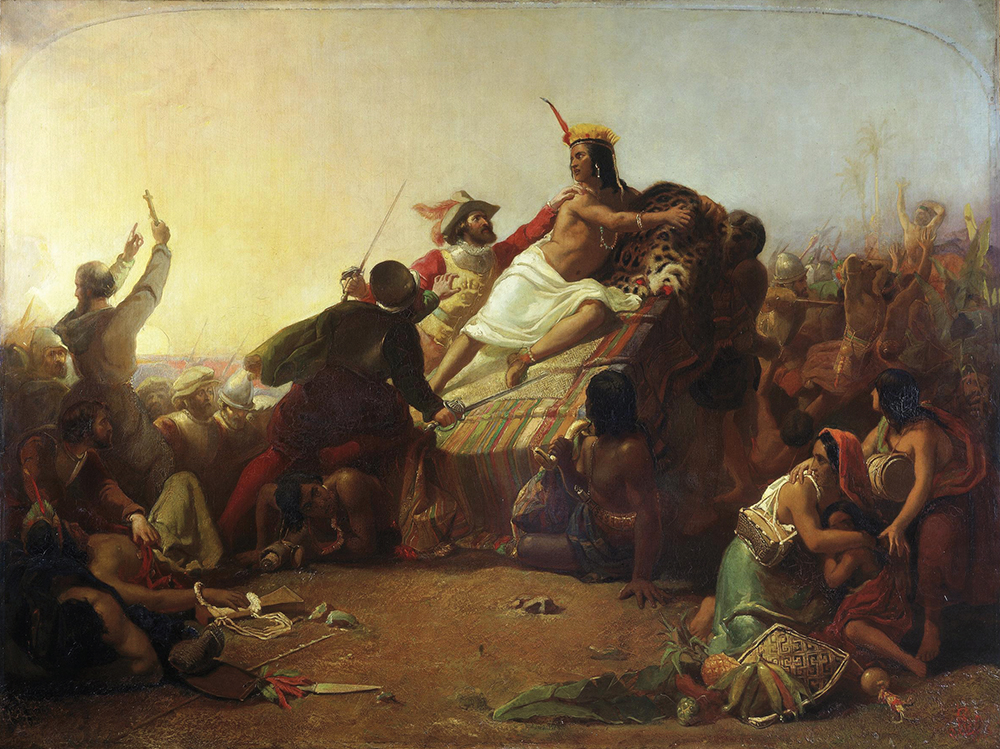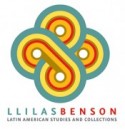BY R. ALAN COVEY
ON NOVEMBER 16, 1532, the Spanish conquistador Francisco Pizarro seized a powerful lord named Atahuallpa during a surprise attack in the highland Inca city of Cajamarca. Despite the cautious interpretations of modern historians like William Prescott and John Hemming—who treat Cajamarca as an important moment in the drawn-out conquest of Peru—popular English-language accounts have come to assume an exaggerated stance. The most prominent of these is Jared Diamond’s 1997 publication Guns, Germs, and Steel: The Fates of Human Societies, a book that has sold millions of copies in dozens of languages. Diamond treats Atahuallpa’s capture as a battle of world-changing significance, evidence of modern Europe’s unstoppable momentum toward global dominance. He presents the encounter at Cajamarca to demonstrate advantages that Pizarro’s conquistadores supposedly held over Atahuallpa and his Inca army. This view is bolstered by the book’s cover art—a vivid nineteenth-century English painting of Atahuallpa’s capture.

Obviously, reducing world history to a snapshot—or a Victorian-era painting—presents interpretive hazards. Foremost of these is the risk of turning European conquest myths into factoids: widely repeated statements thought to be true, but not checked for their accuracy. A brief look at the story of Cajamarca shows how details and interpretations changed as Spaniards and other Europeans pondered the significance of their empire-building efforts.
Perhaps the most important misconception about Cajamarca is that it was a battle; it was actually the violent betrayal of ongoing diplomatic efforts between the Incas and Spaniards. Pizarro and Atahuallpa sent messages back and forth as the Spaniards ventured into the Andean highlands toward Cajamarca. When he arrived, Pizarro sent his cavalry to Atahuallpa’s camp, which was set up a few miles outside the Inca city. The Spaniards presented gifts, along with Pizarro’s offer to fight for Atahuallpa against his enemies. Atahuallpa agreed to meet Pizarro the following day, and he offered the Spaniards maize beer, an Inca sign that the strangers were his subjects.
Atahuallpa went to Cajamarca the following day to confirm this relationship by meeting Pizarro face-to-face. He did not send armed troops into the city ahead of him, but instead rode in an ornate litter, accompanied by an unarmed bodyguard that sang praise songs as they cleared rocks and grass from the narrow causeway that served as a processional route into the city. Atahuallpa proceeded majestically toward a trap that the Spaniards had begun to set in Cajamarca as soon as they arrived there. While their compatriots were in Atahuallpa’s camp, declaring Pizarro’s warm regards and offers of military aid, the Spaniards in Cajamarca placed their artillery on a ceremonial platform in the plaza, and hid mounted troops in the buildings that surrounded it. The Spaniards passed the night prepared for an Inca surprise attack, so frightened that one witness recalled men wetting themselves from sheer terror. They remained in position for the entire day of November 16, as their gunners relayed information on the Inca approach, which they watched from the plaza.

Atahuallpa finally entered Cajamarca in the late afternoon, accompanied by several other prominent lords who also rode in litters. Although some in their retinue carried slings, the battle-hardened veterans who formed the core of Atahuallpa’s army were not among them. Many were still in the Inca camp, waiting for their turn to join the long procession as it slowly crossed the causeway and entered Cajamarca’s streets. When Atahuallpa reached the center of the plaza, the Spaniards were nowhere to be seen. Thinking they might have fled, he sent people into the nearby buildings, where they found the foreigners hidden. Atahuallpa summoned them forth—a power that Inca rulers had over their subjects—and demanded compensation for the plunder and lives the Spaniards had taken as they rode through Inca lands to Cajamarca.
Finally, the Spaniards sent out Vicente de Valverde, a Dominican friar who was the last religious man left on the expedition. Valverde approached Atahuallpa’s litter with a religious book, and through interpreters said some words about the Catholic religion. After Atahuallpa repudiated the authority of the sacred book, Valverde retreated and Pizarro called out the signal to attack. Spanish firearms boomed as mounted horsemen poured out of the buildings and into the plaza, attacking the unprepared ceremonial bodyguard. Pizarro proceeded with his infantry toward Atahuallpa’s litter, and the Spaniards hacked at the litter-bearers until the platform toppled and Pizarro was able to seize Atahuallpa. He pulled his valuable prisoner to safety as the other Spaniards proceeded to massacre the Incas who could not escape the plaza.
A Noble Hostage-Taking
In that moment, the Spaniards did not mistake their hostage-taking for the conquest of an empire. The knightly tradition of medieval Iberia had long emphasized taking noble prisoners on the battlefield and forcing them to pay lavish ransoms to regain their freedom. This was a tactic that Pizarro’s men knew from ballads of ancient heroes like El Cid. It was also a strategy that had recently proven effective in Europe: Spanish forces captured King Francis I at Pavia in 1525, and Pope Clement VII surrendered to Habsburg soldiers during the 1527 sack of Rome. These events led to political concessions and significant payoffs, after which the king and pope were freed. Pizarro quickly came to a similar arrangement with Atahuallpa: in exchange for his freedom, the prisoner would fill a large room with gold, and two more with silver. Meanwhile, the Spaniards allowed Atahuallpa to assemble his court within the palace at Cajamarca, and to act as the Inca ruler. After the agreed-upon ransom was assembled, the Spaniards claimed that Atahuallpa was conspiring with his military commanders to attack them. With little evidence to substantiate this, they held a hasty trial and executed their noble prisoner. Instead of claiming the Inca world for Spain, Pizarro immediately selected an Inca prince to take Atahuallpa’s place as Inca.
Even if the Spaniards had thought that the Inca ruler was an absolute monarch whose capture signified the permanent conquest of his empire, they knew before reaching Cajamarca that Atahuallpa was not the legitimate Inca ruler. The earliest eyewitness accounts clearly show that Pizarro learned from coastal lords and Inca messengers that Atahuallpa’s brother, Huascar, was the acknowledged Inca who ruled in Cuzco.1 Atahuallpa was a military governor in the frontier province of Quito, and although he told the Spaniards that Huascar had attacked him unjustly, he had no legitimate claim to the Inca title. Atahuallpa’s captains had just defeated Huascar and captured him near Cuzco, and the Spaniards were eager to meet with the Inca sovereign to determine their next move. When he learned that Atahuallpa’s men had murdered Huascar on the road to Cajamarca, Pizarro found it convenient to treat the captive Atahuallpa as if he were the Inca, even as he began to build alliances with other would-be Inca rulers.

This is an important point, because Pizarro was contractually bound to seek out native rulers peacefully, present them with an account of Spain’s Catholic mission in the Americas, and attempt to win their support. In 1529, Charles V approved the colonization of Peru by only 250 Spaniards, expecting that the highly developed Inca civilization would make it easy to establish Spanish towns and Catholic missionaries. Pizarro chose to seek out Atahuallpa at Cajamarca after he already knew that the warlord was a tyrant who had carried out atrocities against many of the coastal valleys that the conquistadores passed through. Pizarro must have understood that he could not come to meaningful terms with someone who was not a legitimate sovereign.
Reading between the lines of the eyewitness accounts of Cajamarca, it is clear that the Spaniards who were there understood that they had not won a decisive battle or conquered an empire. They used the appearance of diplomatic negotiations to lure a rebel warlord into an ambush, and after taking him hostage, they used him to collect treasure for themselves. They then executed Atahuallpa so that they could crown an Inca prince who was acceptable to the imperial nobility.
Evolving Meanings for Cajamarca
Given these facts, how did we come to accept the misrepresentation of Cajamarca as a world-changing battle? To get a better perspective, we can look at how European writers and artists depicted the event in the century that followed. Early eyewitness chronicles emphasized two powerful claims: Pizarro was faithfully spreading Christianity, and was representing the sovereign interests of Charles V. In fact, Vicente de Valverde was the only religious man still with Pizarro at Cajamarca; the others had died or returned to Panama to protest Pizarro’s poor leadership. The 1534 woodcut that first depicted Cajamarca emphasized missionary work among uncivilized natives, completely contradicting descriptions of Inca civilization. In fact, the Spaniards struggled to convert native Andeans, undermining their imperial claims in Peru. Over time, Protestants established their own American colonies, and by the 1600s, Spanish writers found themselves treating Pizarro’s survival at Cajamarca as the miraculous evidence of God’s support for Catholic empire-building—not the decisive conquest of the Incas.

Over time, Spaniards retrospectively interpreted the significance of Cajamarca, recasting it into a great battle that advanced Spanish sovereignty and Catholic conversion. After Spain’s American colonies gained independence in the 1820s, the growth of other colonial empires made the narrative of Cajamarca compelling to Europeans and Americans. Spanish sovereignty readily conveyed claims of the superiority of Western civilization, and Pizarro’s miraculous survival illustrated the dominance of the technologies and philosophies emerging from the Scientific Revolution and the Enlightenment. Consciously or not, Jared Diamond’s representation of the myth of Cajamarca raised the event from a nineteenth-century example of European ascendancy to a contemporary metaphor for the advent of modern Western dominance. Today, the story of Cajamarca mistakenly contrasts Western “civilization” with the societies of indigenous people it has too often destroyed, exploited, and marginalized. Historians will continue to work to set the record straight.
R. Alan Covey is professor in the Department of Anthropology at The University of Texas at Austin. His research explores the development and organization of ancient empires, with a particular focus on the Incas of Andean South America. His most recent book is The Inca Apocalypse, forthcoming from Oxford University Press in 2020.
Note
- Anonymous (attributed to Cristóbal de Mena), La conquista del Perú (Seville, 1534); Francisco de Xerez, Verdadera relación de la conquista del Perú (Seville, 1534).


